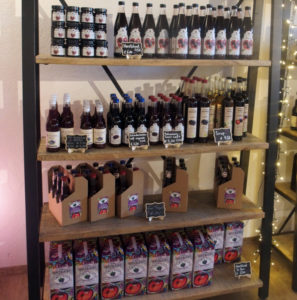The efforts of the International Blackcurrant Association to establish contacts with Russia and come to learn more about blackcurrant growing in Russia resulted in a round table of the IBA Executive with the Russian Berry Union, Russian researchers and growers.
We are happy to share what we learned with you in a short version in this post. You may also watch the whole content of the round table on youtube (see at the end of this article), or (for our members) see the presentations in our web library.
When the IBA meets the Russian Berry Union
For many years, the whole blackcurrant family thought that Russia was the country that grows most of the blackcurrants in the world. Although only for a domestic market. The IBA has now managed to get in touch and establish good relationship with the Russian Berry Union. The first round table in February 2021 allowed us to share our experiences. The outcome has been amazing for the IBA: in total, Russia’s growing surface and yield is far below of what we expected – while the market demand is very high.Now, let’s have a closer look into the subject!
1. Industry and market overview
Blackcurrant growing in Russia – an old tradition. But this tradition means mainly that many people grow a few blackcurrant bushes for their own use in their gardens and orchards. Commercial blackcurrant growing is different.
When we look into commercial berry growing in Russia in general, it appears that the berry growing surfaces have largely declined over the past thirty years. From 45.000 hectares in 1990 to 15.000 hectares in 2020. Berry growing in Russia includes mainly strawberries (67%), raspberries and blackberries (14%), currants (8%), gooseberries, rowanberries and buckthorn. Unfortunately, there has been no promotion of internal production of blackcurrants (IQF, fresh or processed). This has led to a decrease of 47% of the growing surface of red and black currants within 10 years from 2006 to 2016.Blackcurrant growing in Russia takes place mainly in Siberia and Ural, but also in the Western parts of Russia, around Moscow.

Market review
The blackcurrant market (whether fresh or processed) has increased by 30% in 2019. 67% are imported blackcurrants (over 3000 tons in 2019), and most of the imports take place in the high season for the fresh market. The blackcurrants come from surrounding countries. Mainly, Belarus supplies Russia with currants, and only a small share comes from Moldavia, Azerbaijan and Serbia.
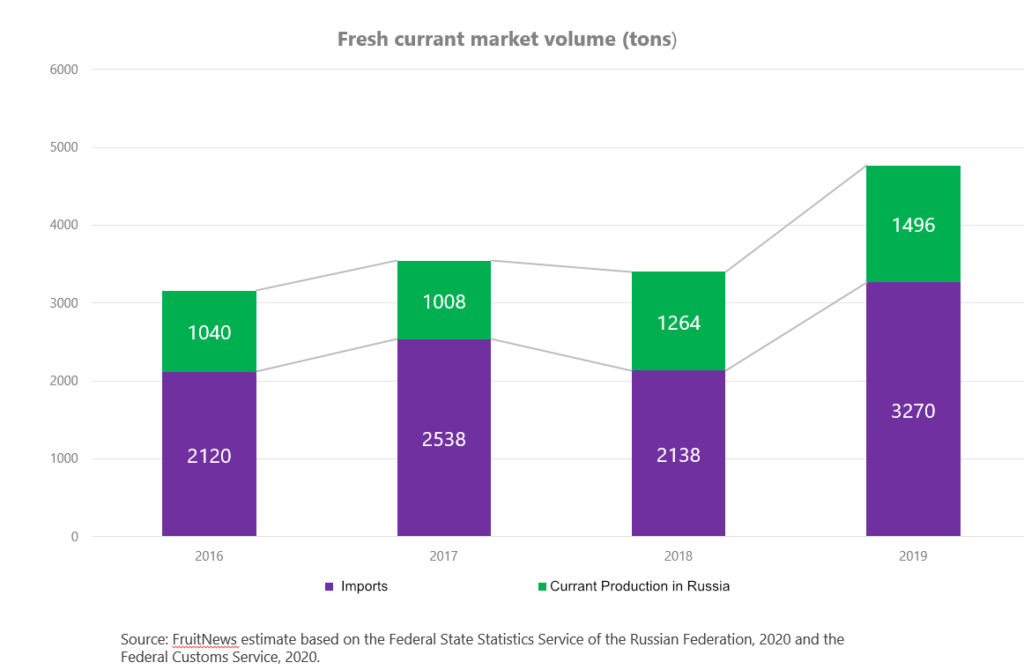
Russia imports twice as much fresh currants as its own production. The main efforts therefore now go into improving the yields – and thus increase the share of domestic currants in the market.
Difficulties to overcome
But for being successful in increasing the domestic berry production, Russia faces several challenges. The need of efficient and up-to-date plant protection products, authorized in the Russian Federation, is not the only one. It already starts with difficulties in the supply of planting material. As we were told, planting material is mostly self-produced and does not reach the quality standards needed for an efficient production. Furthermore, the lack of knowledge about modern growing technologies, presale preparation and storage of berries increase the difficulties. And finally, when it comes to working in the fields and harvesting, Russia also faces a shortage of skilled staff and seasonal workers.
To sum it up, commercial blackcurrant growing in Russia crucially needs modernization before it can meet the demand of the internal market. Until then, imports will stay a necessity.
2. Key sales channels and quality standards for Russian blackcurrant growers
As we pointed out earlier, reaching the quality standards starts not only with the right land and soil. The Russian blackcurrant growers are missing good planting material and good plant protection products. Many of those used in Europe are not registered in Russia. As a consequence, the yields in Russia are far below the expectations of European growers for their yields. For a Russian blackurrant grower, a good yield for a field with plants of around seven years and with a good irrigation system corresponds to around 2 or 3 tonnes per hectare. This represents only a fourth of a normal harvest in Europe!
Destination and prices
What is totally different in blackcurrant growing in Russia from blackcurrant growing in all other parts of the World is the final destination of the currants. In Russia, 80% of the yield go into the fresh market. This is the reason why harvesting methods are also in the focus of the growers. They now concentrate rather on mechanical harvesting than hand picking – for price reasons. Of course, harvesting with machines costs eight times less than hand picking. The calculation is simple: for a grower, the cost of one kilo of handpicked blackcurrants is 80 Rubels. This corresponds to around 0.90€. For being profitable, he should sell them for 250 Rubels – 2.90€. The average price of blackcurrants in the market is of 80-100 Rubels (around 1€) per kilo, though. And the price goes down as the season advances.
Blackcurrant sales channels in Russia
Furthermore, storing blackcurrants is of big interest to the growers. Blackcurrants can be stored without specific cooling systems at around 8°C for a maximum of 10 days. This is pretty close to the practices in Europe. There is no solution either for storing our little black pearls for the fresh market. Yet, the fresh market in Europe does not count as much as the fresh market in Russia! Finally, blackcurrant growing in Russia struggles with the same challenges than in Europe. Above all others is weeding. Drought and other bad weather conditions have also come into the center of attention lately.
Finally, blackcurrant growing in Russia struggles with the same challenges than in Europe. Above all others is weeding. Drought and other bad weather conditions have also come into the center of attention lately.
As a conclusion to ever-lasting interrogations, we can see that the situation for blackcurrant growing in Russia is more difficult than in Europe. This is due to the final use of the fruit (fresh market!) and the same climatic and agronomic challenges than anywhere else. Yet, at the starting point with planting material, fertilizers and plant protection products, the Russian growers don’t benefit from the same “comfort” than growers in Europe.
3. Most popular varieties for blackcurrant growing in Russia
In its varietal research, Russia concentrates on yield, fruit size and compatibility with mechanical harvest, which is the future for blackcurrant growing in Russia.
Just like in most other countries of the World, people in Russia tend to move towards a healthier lifestyle. They focus on organic and healthy food – instead of fast food. Not surprisingly, berries have a high potential in this market.The average fruit consumption in Russia is of 100 kg per year and per capita. Berries represent 7 kg. We mentioned that Russia imports the biggest share of the berries. In general, imports represented approximately 50 000 tonnes per year! The growing surfaces have again decreased in 2019, though, and the trend goes on.
Criteria for varietal selection
All recent varieties developed by the Russian Research Institute are suitable for mechanical harvesting methods.Blackcurrants have the advantage of containing many nutrients, and moreover giving a high yield. Mecanisation is possible in almost every stage of the process. This is why they are one of the leading cultures in Russia.
One new variety every year
In the last 20 years, more than 20 varieties have been brought into the market. 11 of them are resistent to mildew, some to gall mite and some to rust. Varieties like Arabka, Chrivanya, Chernavka and Niura have high potential for the growers. The Institute, alongside the development of new varieties, also provides consultancy to the growers.
4. Blackcurrant growing technologies
Globally, the difficulties to overcome are similar to the ones in Europe. Nevertheless, the climatic conditions in Russia are not the same.
It is in fact important to provide the market with the appropriate varieties of blackcurrants. The goal for the breeders is to adjust to the climate change – and already, several varieties are available. Another solution would be to find new places for blackcurrant growing in Russia.
Climatic challenges throughout the year
Of course, the varieties should be resistent to certain pests and diseases – which is true for any variety in any part of the World. Stress factors in Russia are:
– frost periods in winter (with temperatures that should not go below -5° for too long).
– in spring: frost, moisture in the soil, and big differences in temperatures between day and night.
– heat threatens the quality and quantity of the yield in summer.
– in autumn: periods of cold without snow.
For cost-effectiveness, aim at 7-9 tonnes / hectare
In terms of cultivation, Russian agronomists recommend to select the varieties according to their production potential. A grower should plant up to 5.700 plants per hectare. A field is cost effective only with a yield of 6-8 tonnes / hectare. In total, 30-50 hectares land are necessary for a culture to be profitable in Russia. To achieve profitability, it is recommended to follow the advice of specialists. The space between shrubs, between the lines, pruning and shaping the shrubs to allow mecanical harvest are essential for success.
A successful meeting
The experience of sharing our knowledge and learn from each other was especially positive during the round table. Almost 5 hours of videoconferencing with simultaneous translation made it possible for everyone to get an insight into each others markets and growing technologies. It opened our eyes and minds, and we will certainly all take profit from this experience in the long term.
As we could see, the criteria for variety selection, growing methods and harvesting (including machines) are very different in Russia. Climate plays a major role for the growers. The requirements for blackcurrant growing in Russia are different from other countries.
On the other hand, the popularity of the fruit itself is totally different. Blackcurrant is a major fruit for Russians, especially as fresh, raw fruit.
Our thanks for a deep insight into blackcurrant growing in Russia go to Irina Koziy – General Director of the Russian Berry Union and Fruit News Information Agency, Irina Kozlova – Leading Researcher of the Federal Scientific Center Michuring, Wladislaw Khanov – Chief Agronomist for horticulture of Sady Privolzhiya of Volzhskiy Posad Group and fruit and berry grower of 1000 ha, including about 80 ha of blackcurrants, Elena Kardapolova – Executive Director of Surgutskoe Co, fruit and berry grower on 2000 ha, including 36 ha of blackcurrants and planting material supplier, Anastasia Bakhotskaya – Researcher of the All-Russia Research Institute of Orchard Cultures Breeding and Tatiana Zhidekhina – Deputy Director of the Federal Scientific Center Michuring.
View the full video of the round table

 Related to the research on blackcurrants and anthocyanin, more awards have been decerned. Not amazingly, it is all about New Zealand blackcurrant extracts. New Zealander Fleur Cushman harnessed the natural power of New Zealand blackcurrant and started the commercialization of blackcurrant extract capsules.
Related to the research on blackcurrants and anthocyanin, more awards have been decerned. Not amazingly, it is all about New Zealand blackcurrant extracts. New Zealander Fleur Cushman harnessed the natural power of New Zealand blackcurrant and started the commercialization of blackcurrant extract capsules.

 Finally, blackcurrant growing in Russia struggles with the same challenges than in Europe. Above all others is weeding. Drought and other bad weather conditions have also come into the center of attention lately.
Finally, blackcurrant growing in Russia struggles with the same challenges than in Europe. Above all others is weeding. Drought and other bad weather conditions have also come into the center of attention lately.

 Together with a breeding institute and universities, the cooperation model with Hungarian farmers resulted in the plantation of new, prefectly suiting varieties for the region. They have less environmental impact, as they are resistent against the main deseases. This, of course, reduces the need for plant protection products – and therefore results in lower production costs. In total, 900 farmers participated in this programme. They planted a total of 3700 hectares of new orchards between 2000 and 2015. For this, Austria Juice supported them with a 15 years contract and several advisors to support the farmers with their everyday challenges.
Together with a breeding institute and universities, the cooperation model with Hungarian farmers resulted in the plantation of new, prefectly suiting varieties for the region. They have less environmental impact, as they are resistent against the main deseases. This, of course, reduces the need for plant protection products – and therefore results in lower production costs. In total, 900 farmers participated in this programme. They planted a total of 3700 hectares of new orchards between 2000 and 2015. For this, Austria Juice supported them with a 15 years contract and several advisors to support the farmers with their everyday challenges. “The efficiency of apple production is higher now and we have full traceability of our raw material. We now aim to achieve the transformation into organic production in the framework of this project”, Julia Wurzer continues.
“The efficiency of apple production is higher now and we have full traceability of our raw material. We now aim to achieve the transformation into organic production in the framework of this project”, Julia Wurzer continues.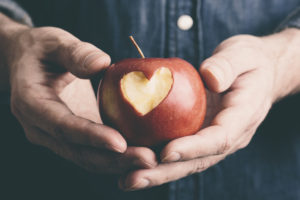
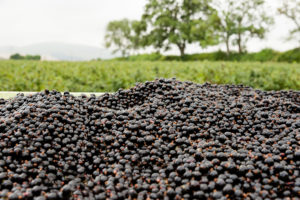 Of course, this does not (yet) concern blackcurrants. But the whole project aims at continuously improving the groupwide sourcing system.
Of course, this does not (yet) concern blackcurrants. But the whole project aims at continuously improving the groupwide sourcing system.
 Before we talk about new challenges related to climate change, let’s have a look at the basics. Blackcurrants grow naturally in temperate climate. Their home is the region spanning between the tropics and the polar regions of Earth. They need distinct seasonal changes: warm summers and cold winters.
Before we talk about new challenges related to climate change, let’s have a look at the basics. Blackcurrants grow naturally in temperate climate. Their home is the region spanning between the tropics and the polar regions of Earth. They need distinct seasonal changes: warm summers and cold winters. The blackcurrant is not very demanding in terms of soil, sunshine and water. The natural conditions in its climatic zone are perfect, and the plants don’t require special layouts. They just grow – and give a good yield. Mechanical harvesting has developped in the 1980ies and made it easy for growers to harvest huge quantities of blackcurrants within a few days and with very few workers. The juice concentrate business paid good prices for blackcurrants for several years, and growers could earn a good living. It sounds like paradise.Then came overproduction, and what had been a dream world for many has become a nightmare within a few years. The blackcurrant growing surface kept growing, and resulted in overproduction, especially in Poland. This naturally led to lower prices.Today, the situation starts getting back to normal, as the production in Poland decreases little by little and corresponds more to what the market demands.
The blackcurrant is not very demanding in terms of soil, sunshine and water. The natural conditions in its climatic zone are perfect, and the plants don’t require special layouts. They just grow – and give a good yield. Mechanical harvesting has developped in the 1980ies and made it easy for growers to harvest huge quantities of blackcurrants within a few days and with very few workers. The juice concentrate business paid good prices for blackcurrants for several years, and growers could earn a good living. It sounds like paradise.Then came overproduction, and what had been a dream world for many has become a nightmare within a few years. The blackcurrant growing surface kept growing, and resulted in overproduction, especially in Poland. This naturally led to lower prices.Today, the situation starts getting back to normal, as the production in Poland decreases little by little and corresponds more to what the market demands.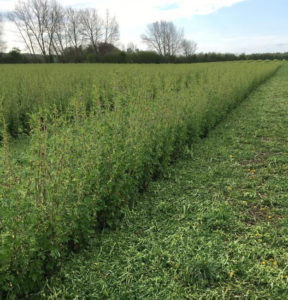






 Over the past years, we have regular reports from growers who complain that part of their harvest – if not all – is destroyed within a single night of frost in April / May.
Over the past years, we have regular reports from growers who complain that part of their harvest – if not all – is destroyed within a single night of frost in April / May.
 The blackcurrant fields of Burgundy are almost the farthest South in Europe. And although the variety may play a major role in the problem with scales, they now appear also further North. Is there a relation with the climate change? We cannot foresee this yet, but it is a possibility. Together with changing conditions as far as temperatures and humidity are concerned, deseases will develop or decrease accordingly.
The blackcurrant fields of Burgundy are almost the farthest South in Europe. And although the variety may play a major role in the problem with scales, they now appear also further North. Is there a relation with the climate change? We cannot foresee this yet, but it is a possibility. Together with changing conditions as far as temperatures and humidity are concerned, deseases will develop or decrease accordingly.


 Nevertheless, there is still a long way to go. But unfortunately, we are running out of time. It is time to act, more than to think. Because one thing is sure: we will first see and suffer from the effects of climate change in agriculture.
Nevertheless, there is still a long way to go. But unfortunately, we are running out of time. It is time to act, more than to think. Because one thing is sure: we will first see and suffer from the effects of climate change in agriculture. Previous research from the Institute has highlighted the threat that climate change poses to blackcurrant farming. As we all know, the plants need a period of sustained cold weather in the winter. Without the winter chill, they yield less fruit and have a shorter lifespan.The UK’s 10 hottest years on record have all occurred since 2002. Winters in the UK and all over the world are getting gradually warmer. This is one of the challenges that all blackcurrant growers will have to deal with.
Previous research from the Institute has highlighted the threat that climate change poses to blackcurrant farming. As we all know, the plants need a period of sustained cold weather in the winter. Without the winter chill, they yield less fruit and have a shorter lifespan.The UK’s 10 hottest years on record have all occurred since 2002. Winters in the UK and all over the world are getting gradually warmer. This is one of the challenges that all blackcurrant growers will have to deal with. 
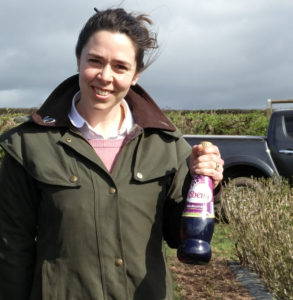 “Together with
“Together with 





























